|
School University (1), Spano (2) |
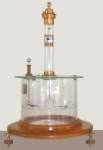 (2) (2)
|
||
|
Function To study the laws on the action between electric charges and between magnetic poles. | |||
|
|||
|
Description The cylindrical glass container rests on a mahogany circular basis with brass foot screws. It has a grade division at half height. The cover is a glass disk that rests on the container and is driven by three ebonite rolls. From the centre of the cover a glass tube rises with a friction turning graduated head. The height of the set can be regulated, as the joint of the suspension is assigned to a sliding bar. As accessories of the apparatus we have:
| |||
 Menu
Menu
|
School University |
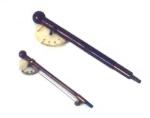
|
||
|
Function Instrument for the measure of the electric charge. | |||
|
|||
|
Description It is formed by a little pendulum made of an insulating pole ending with a metallic part. An elder ball is suspended from the pole with a silk thread. By placing the metallic part in contact with a charged body, the elder ball has an electrostatic repulsion and it is pulled back. On a quadrant placed on the pole we can read the angular deviation that is linked to the charge intensity. | |||
|
School University |

|
||
|
Function Instrument for the measure of the electric charge. | |||
|
|||
|
Description The instrument is placed inside a cylindrical brass container, with four rectangular little windows corresponding to the quadrants of the instrument and a circular little window corresponding to the mirror. From the container supported by the four leveling screws, rises a brass tube from which an 8 shaped needle hangs by a silk thread. The needle can turn inside a cylindrical case divided into four quadrants, anchored to the top of the container by insulating poles. The opposed quadrants are connected by metallic wires. Each couple is connected to a binding-post placed over the top of the container From the bottom of the needle branches off a platinum thread that ends with two threads of the same metal welded transversally to form a double cross.The end of the thread ends in a basin that contains concentrated acid. This thread is used to damp the oscillations of the needle and to connect the needle, through the electrolytic solution, to another binding-post placed on the top of the container, from which departs another thread that ends in the basin that contains the acid. A mirror welded in the middle of the platinum thread is used to reflect a light beam on a graduated scale so as to obtain an amplification of the rotation. The unknown potential of the needle is measured on the basis of the needle rotation obtained when the quadrants are connected to known potentials (the poles of a cell). The needle turns until the torque due to the electrostatic interaction is balanced by the torsion of the thread. | |||
|
School University (1), Spano (2) |
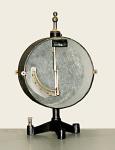 (2) (2)
|
||
|
Function Instrument for the measure of the electric charge. | |||
|
|||
|
Description The insulation is made of ebonite and sulphur. The cylindrical zinc case can be closed with two zinc covers, that leave a little opening in correspondence of the scale. The tripod has a binding post to earth the case and a foot screw. As accessories we have a metallic plate to replace the sphere and a second metallic plate with an insulating handle and a varnished glass disk, to change the instrument into a condensing electroscope. | |||
|
School Azuni |
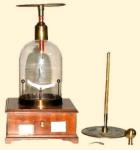
|
||
|
Function Instrument for the measure of the electric charge. | |||
|
|||
|
Description A glass bulb is placed over a wooden case. A metallic pole with two gold leaves at one end arrives inside the bulb through the neck. On the other end we can have a sphere, a pit or the plate of a capacitor. Inside the bulb we have an index that indicates the divergence of the leaves. By placing a charged body in contact with the sphere, the leaves will charge with the same sign and diverge. The leaves diverge even if the sphere is charged by induction. In fact they both charge with the opposite sign of the sphere. | |||
|
School Spano (1), Pellegrini (2), University (3) |

|
||
|
Function Instrument for the measure of the electric charge. | |||
|
|||
|
Description The metallic case is insulated but it is equipped with a lower hook to earth it. The two aluminium leaves are held by a shining sheet, insulated by a big ebonite sleeve and a sulphur cylinder. The two parallel sliding planes defend the leaves and are used to modify the sensibility of the instrument. To give the leaves a sufficient charge we rub the plate collector with a feather duster, without stopping on the plate, and with the case on the earth. If we want to give the leaves a charge opposite to the previous one, then we must eliminate the earthing, we rub the case with the feather duster and we touch the nickered plate. During this second operation it is advised not to rub the glass wall with the feather duster, because the leaves would be attracted violently and they would break. The capacitor plate must be handles with the ebonite end by which the glass column ends. The instrument is equipped with a thin glass disk to use as a dielectric. It must be interposed between the two plates to form the capacitor. | |||
|
School Spano |
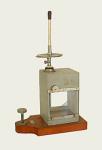
|
||
|
Function To execute with precision the quantitative experiments the electrostatic induction. | |||
|
|||
|
Description The prismatic aluminium case is fixed on a mahogany basis, that has two ebonite feet and a leveling screw. To insulate the case we must place an ebonite disk under the leveling screw. The instrument is equipped with a small plate manoeuvrable from the outside, that can close the leaf against its support and always defend it. The same small plate, placed nearer or farther from the leaf changes the system capacity and earthing and transforms the electroscope into Gauginís electrometer. The instrument is equipped with a capacitor plate and a varnished glass disk. | |||